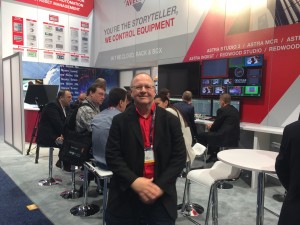SVG@NAB Perspectives: Aveco’s O’Brien on Shaking Up Production Automation With ‘Take 2’
Aveco has been making waves in production automation for several years, always with a focus on live broadcasting. At this year’s NAB, the company switched up its traditional focus in favor of a new production automation platform designed for studio recording. With Take 2 Studio Production Automation, producers and directors can execute their productions in a non-linear fashion and yell “cut!” as many times as they’d like, allowing them to create a more sophisticated production that is not as dependent on postproduction. SVG sat down with Aveco’s Global SVP of Sales Jim O’Brien to talk about what the new platform means for sports broadcasters.
What’s new for Aveco at the show?
We have two new products. The first is Take 2 Studio Production Automation, and this is designed for higher-end sports newsmagazines and other productions focused on studio production going into recording. It allows people to have the production switcher control, graphics, audio, lighting, camera robotics, and virtual set all under our automation control. When a director wants to say ‘cut,’ he can just say ‘cut’ — we can use a simple timeline to recue at the right moment and synchronize all of the production elements, allowing you to press one button to ‘take two’ — take the second take. It’ll record, and at the end, you hit compile to finish the production, which is comprised of the best takes.
And, you don’t have to do the scenes in any given order. You can do the scenes individually, and it allows you to do high-end studio productions… It elevates the production values of sports newsmagazines, and allows for unprecedented efficiency in producing the show, getting it done right in the studio, and not having to take everything into post. It’s a wonderful innovation in studio production automation.
Aveco has long been known for production automation. How does ‘Take 2’ build on your existing platforms?
It uses the same base of control as we have for all existing production equipment [and] is designed for studio recording purposes. We have for many years been doing live-to-air studio production automation — combining graphics and virtual sets and production switchers and audio mixers and lighting live to air — so we still do that, and that works great. The differentiation is this is now designed for [directors to do multiple takes]. You can’t do a cut going live to air, so lots of times directors and producers sort of live with some problem in the production just because it’s live to tape or live to server. Now, you can easily fix it — just say ‘cut,’ recue on a timeline, press one button, and you’re resuming the production. Then compile at the end, and the show is wrapped.
So it gives directors and producers more flexibility in their productions.
It’s tremendously more flexible. [They can] do more advanced production techniques, more innovative looks; they can integrate more elements on the set, integrate control of the video walls and the graphics on set, and do higher-end looking stuff with the same low cost point and the same precision of control that we’ve been doing live to air with news.
Take 2 Studio Production Automation is great for sports productions of all types because we do camera robotics control, both locally and remotely. The days of remote sports production are maturing, and we — with our architecture — have wonderful capability to automate studio productions with remote productions [and] work with trucks. An application that is very relevant for us to do from the truck is the [press] conferences. With a simple remote client, you could be in the truck, take care of editing, take care of live cutting, and enhance the production of the [press] conferences after games. Right now, those have very poor production techniques; it’s usually just one camera on the speaker — you don’t see the laughing from the audience, you don’t see the people asking the questions — and you can easily do that with the remote robotics control of a simple PTZ camera to do the cutaways from the truck. One little box over in the [press] conference room being controlled by the truck — that’s an application for our [system].
And you’re also launching a second new product at the show?
That is our Redwood Lite and that is a graphics system plus simple playout designed for on-set roll-ins of graphics, roll-ins of video, and simple playout applications, especially for universities and schools that are launching their own web channels and still want high-end precision control but need a lower-end form factor and cost.
What are you most excited about at this year’s show?
We’re extremely excited about ATSC 3.0. There are capabilities there that we are really looking forward to working with and implementing. And we’re really happy, naturally, to be working with all of the IP video because we’re a control layer. We’re integrated with all of the manufacturers of production switchers and graphics systems and video servers and they’re all going IP and that’s great for us because our control architecture is still controlling it all perfectly and just letting us add value to the all-IP architectures of the business.

